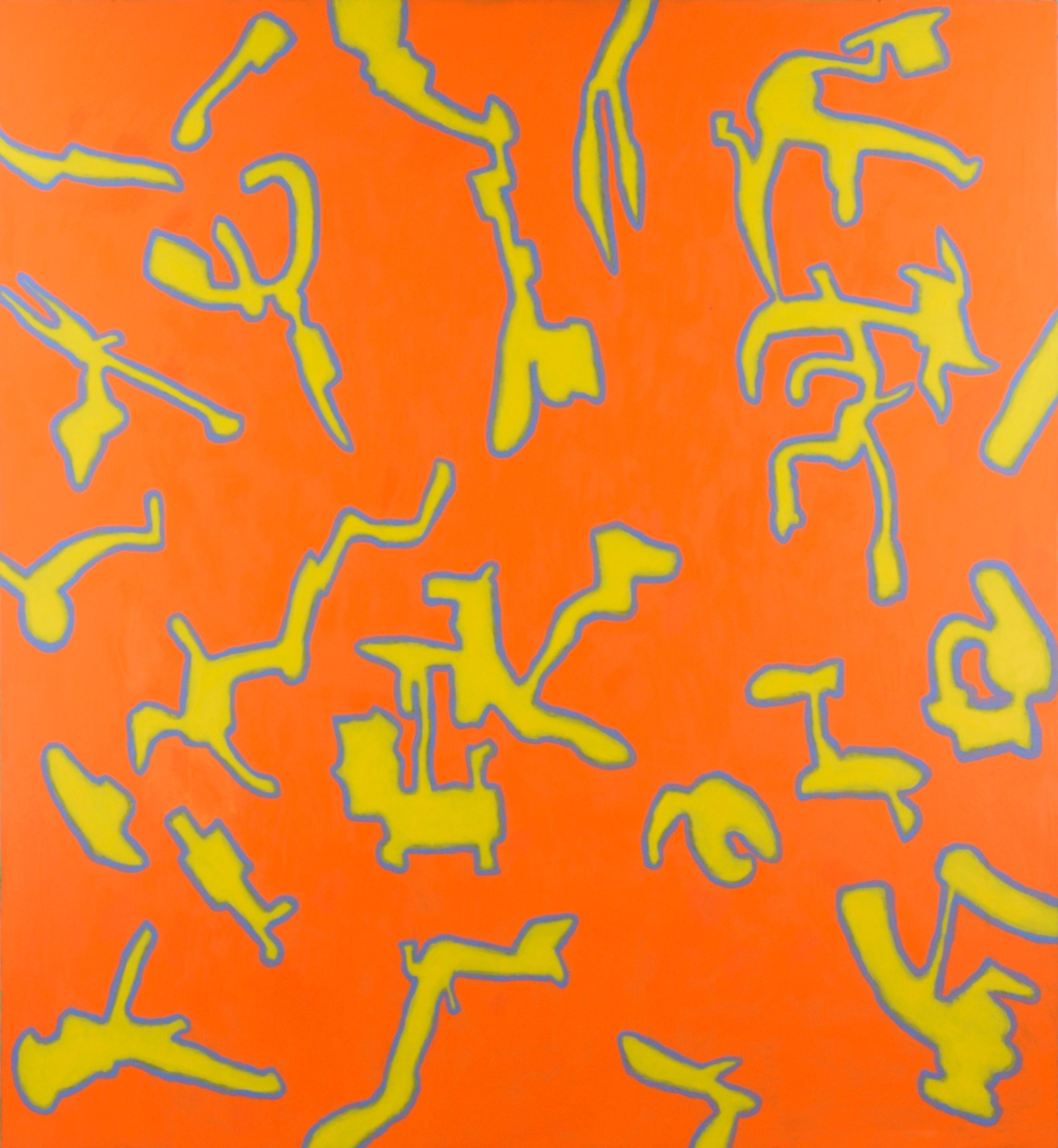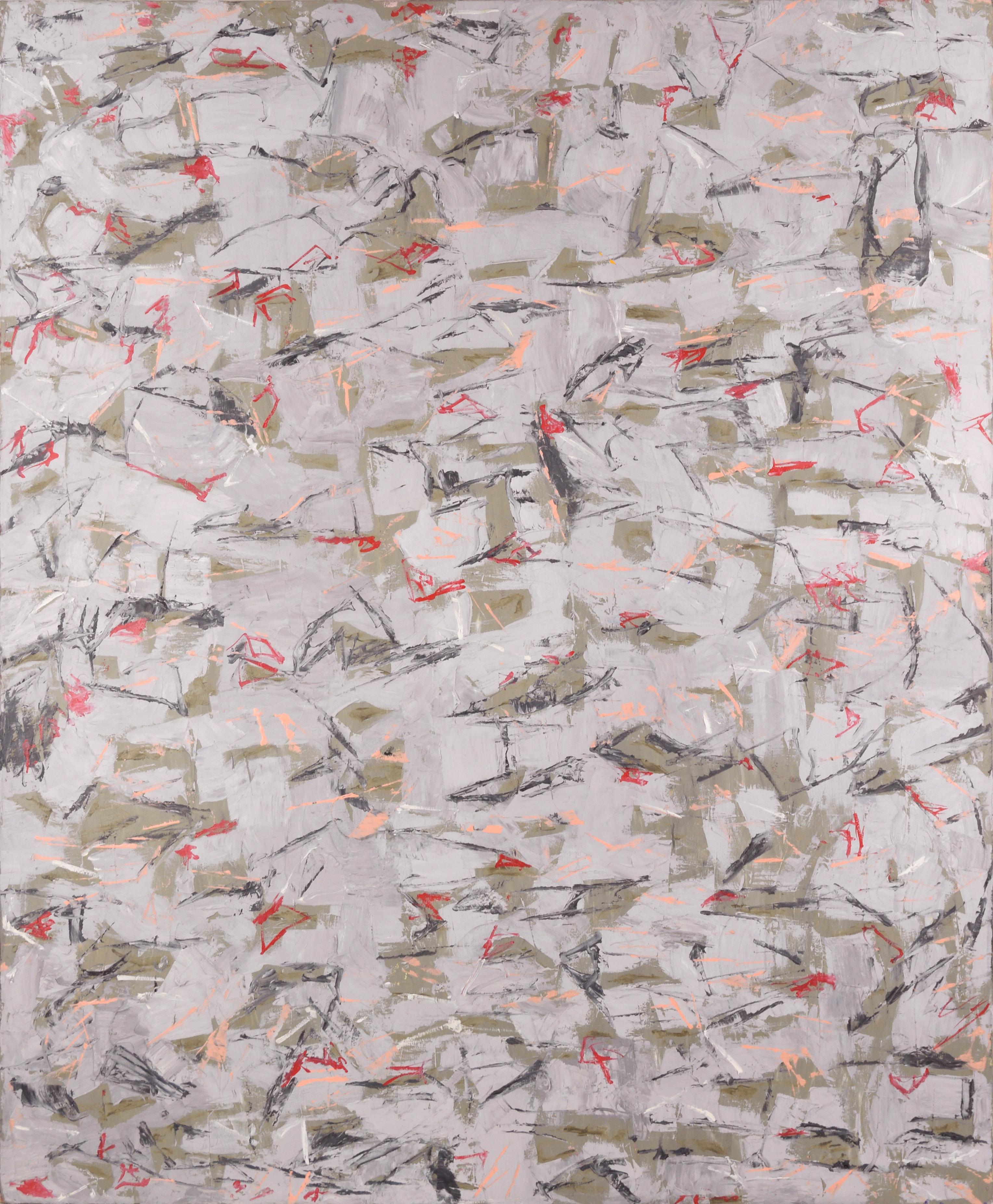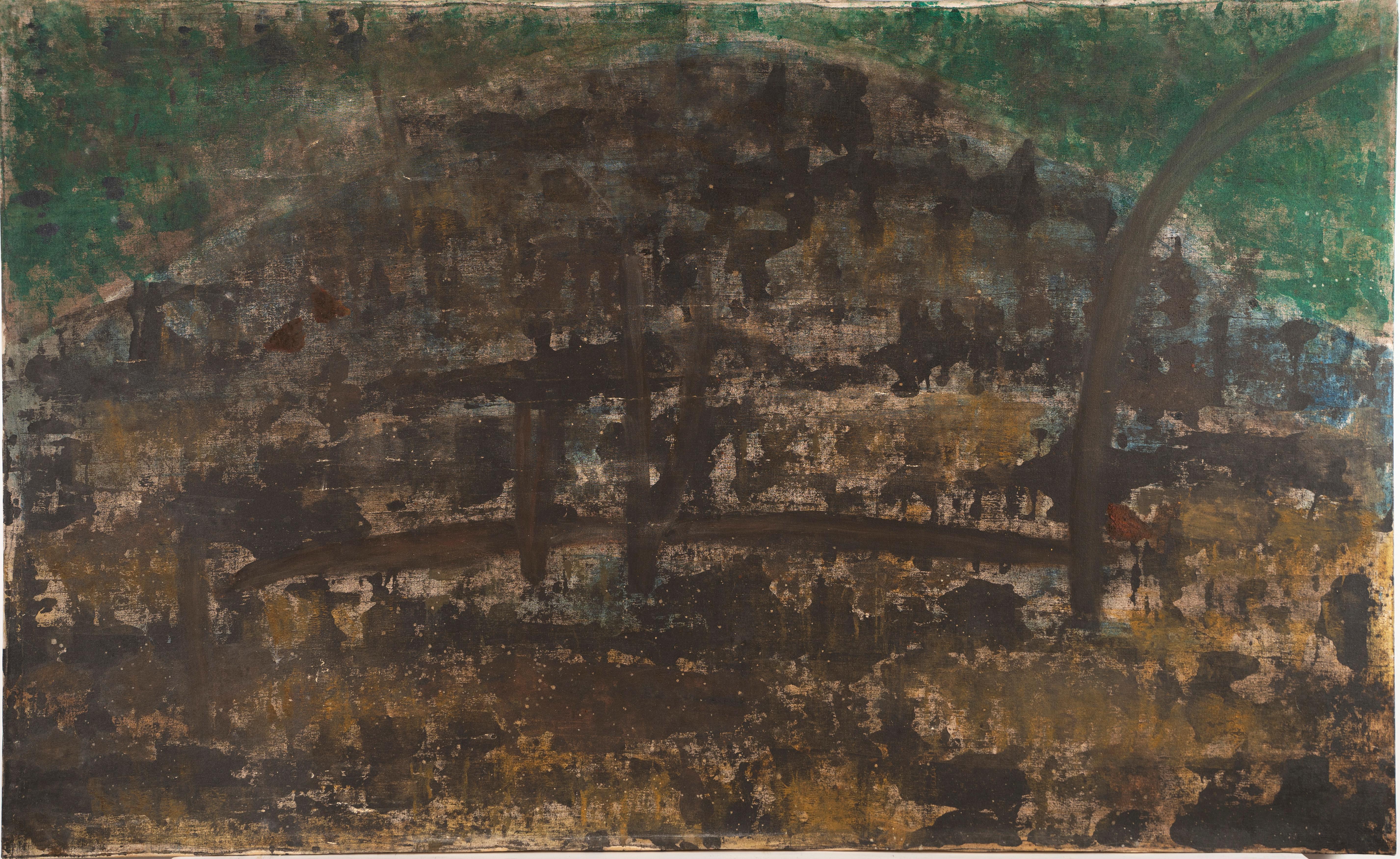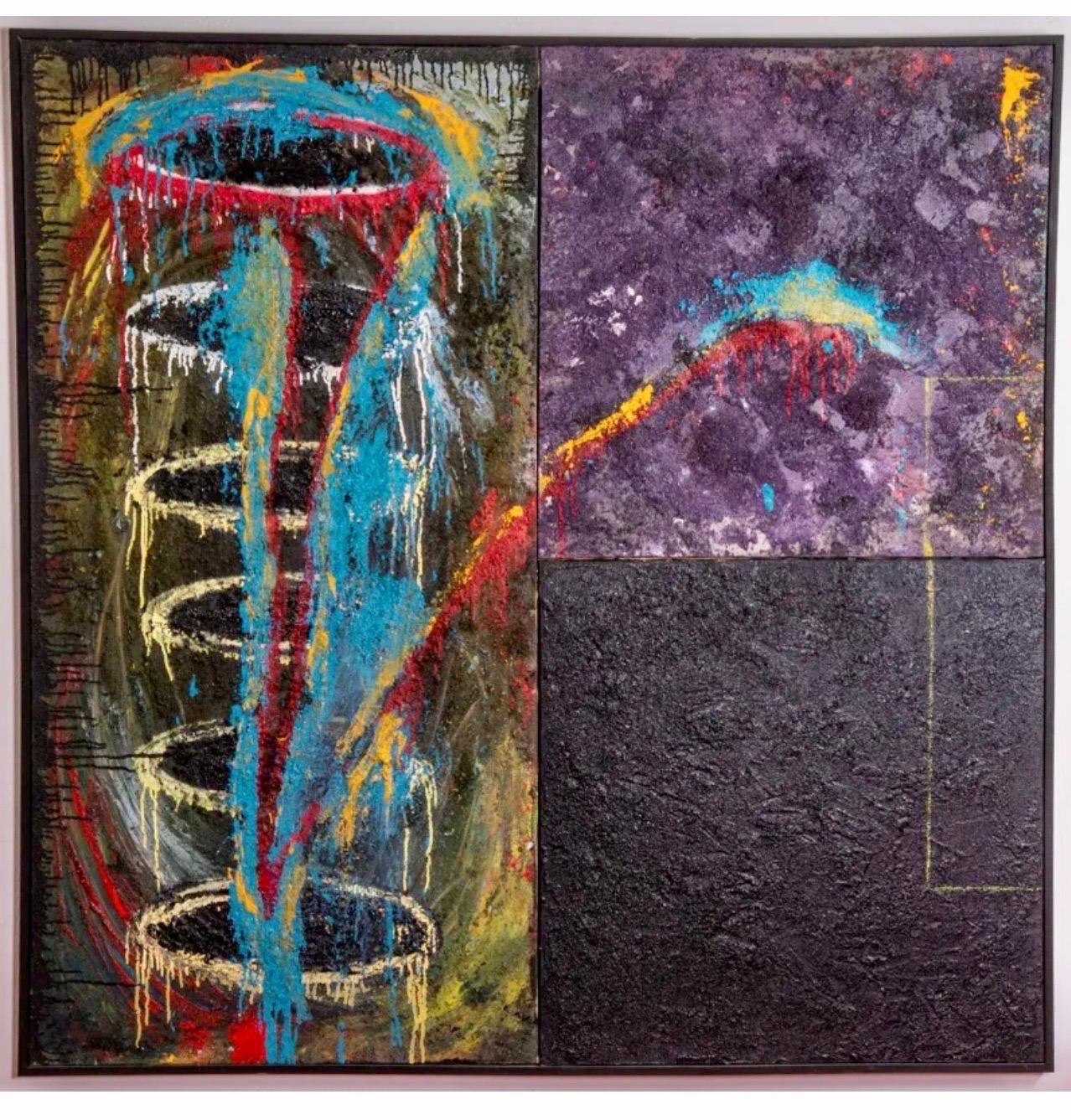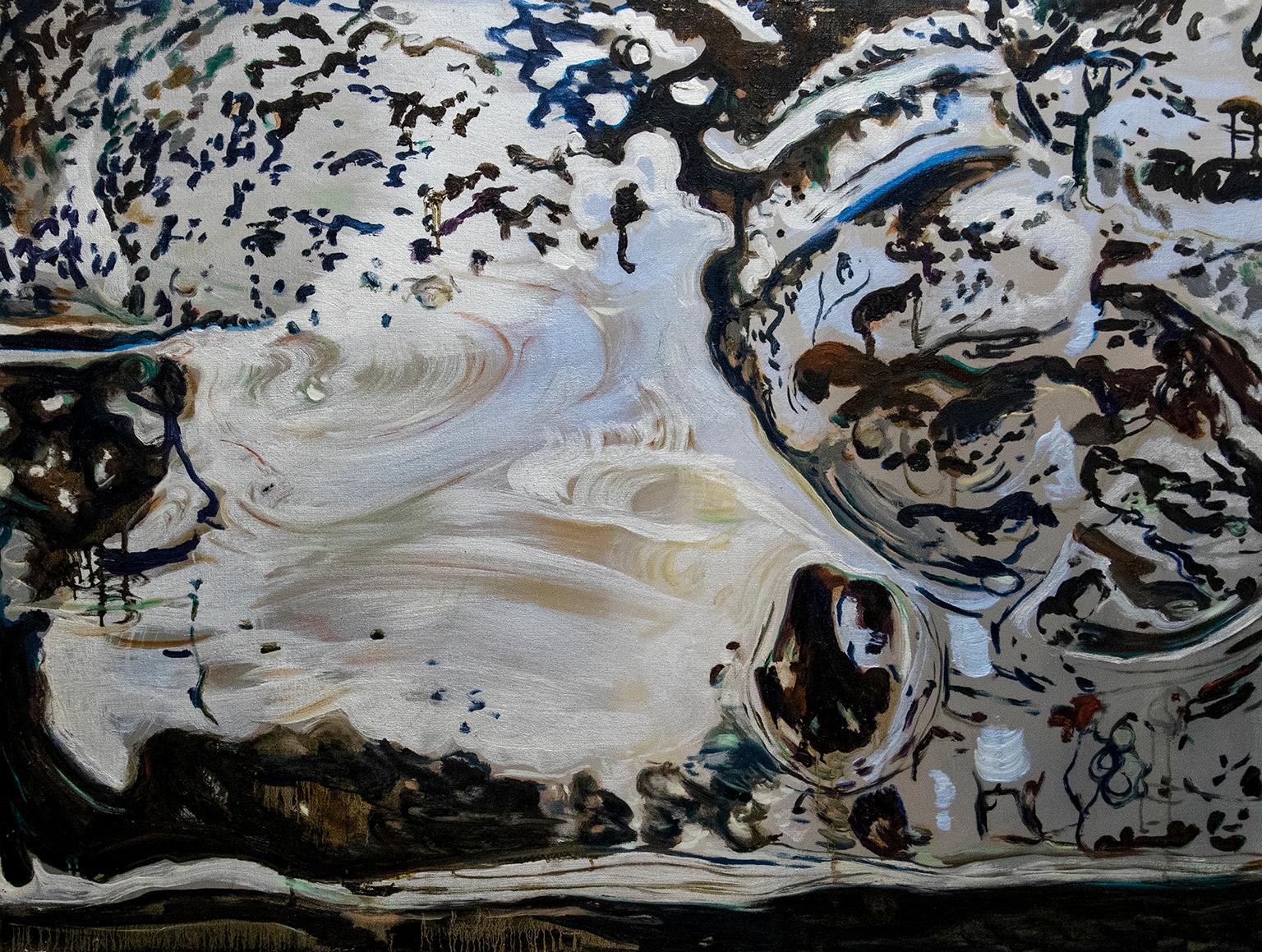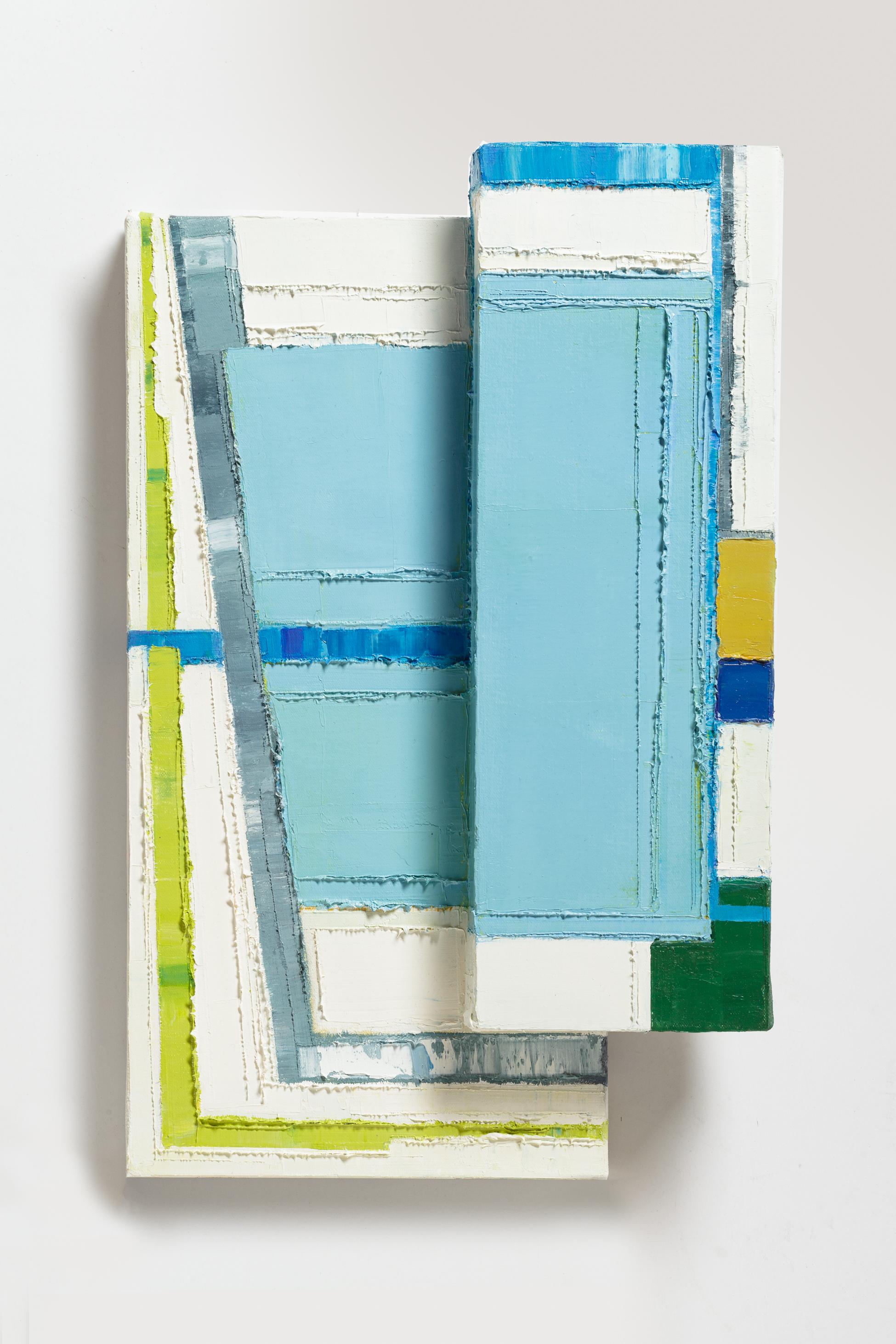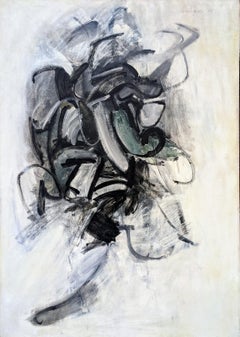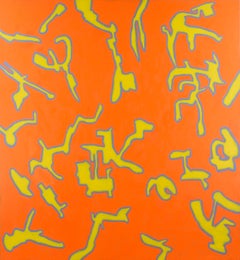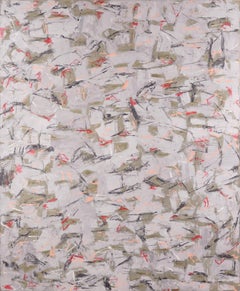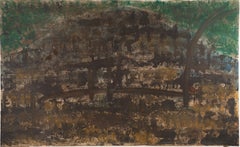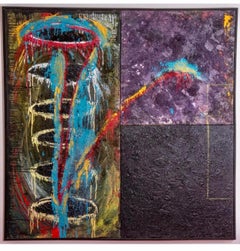Items Similar to "Cave Drama" Boris Margo, Abstract Surrealism, Surrealist landscape, Modernist
Want more images or videos?
Request additional images or videos from the seller
1 of 10
Boris Margo"Cave Drama" Boris Margo, Abstract Surrealism, Surrealist landscape, Modernist1938
1938
About the Item
Boris Margo
Cave Drama, 1938
Signed and dated lower left
Oil on canvas
22 x 30 inches
Best known as a painter of surrealist imagery, Boris Margo was born in Wolotschisk, Ukraine, in Russia. In 1919 he enrolled at the Polytechnik of Art at Odessa, and in 1924 received a grant to study at the Futemas (Workshop for the Art of the Future) in Moscow. A second grant enabled him to study the work of the Old Masters in the Hermitage Museum in Leningrad and to attend Pavel Filonov's Analytical School of Art in 1927.
In 1928 Margo received a certificate from the Polytechnik and immigrated to Montreal, where he worked as a muralist for a year. Moving to New York City in 1930, he studied at the Roerich Museum, and two years later began teaching there. He began experimenting with celluloid and acetone in his printmaking and was also an early user of the decalomania technique in oil painting.
In 1943 he became an American citizen. Five years later Margo founded a Creative Art Seminar (later called Artists Gallery) in Orlando, Florida, and a year later established a similar venture in Provincetown, Massachusetts.
Margo's first solo exhibition was at the Artists Gallery in New York City. Other important shows were held at the Brooklyn Museum, the Tweed Gallery at the University of Minnesota, Duluth, and the Michael Rosenfeld Gallery in New York in 1993.
- Creator:Boris Margo (1902, American)
- Creation Year:1938
- Dimensions:Height: 22 in (55.88 cm)Width: 30 in (76.2 cm)
- More Editions & Sizes:Unique piecePrice: $24,000
- Medium:
- Movement & Style:
- Period:
- Condition:
- Gallery Location:New York, NY
- Reference Number:1stDibs: LU1841214453192
About the Seller
5.0
Gold Seller
Premium sellers maintaining a 4.3+ rating and 24-hour response times
Established in 2022
1stDibs seller since 2022
98 sales on 1stDibs
Typical response time: <1 hour
- ShippingRetrieving quote...Shipping from: New York, NY
- Return Policy
Authenticity Guarantee
In the unlikely event there’s an issue with an item’s authenticity, contact us within 1 year for a full refund. DetailsMoney-Back Guarantee
If your item is not as described, is damaged in transit, or does not arrive, contact us within 7 days for a full refund. Details24-Hour Cancellation
You have a 24-hour grace period in which to reconsider your purchase, with no questions asked.Vetted Professional Sellers
Our world-class sellers must adhere to strict standards for service and quality, maintaining the integrity of our listings.Price-Match Guarantee
If you find that a seller listed the same item for a lower price elsewhere, we’ll match it.Trusted Global Delivery
Our best-in-class carrier network provides specialized shipping options worldwide, including custom delivery.More From This Seller
View All"Katmandu, " Alison Hildreth, Abstract Expressionist, Female Artist
By Alison Hildreth
Located in New York, NY
Alison Hildreth (American, b. 1934)
Katmandu, 1980
Oil on canvas
54 x 52 inches
Signed, titled, and dated on the reverse
Alison Hildreth was born in B...
Category
1980s Abstract Expressionist Abstract Paintings
Materials
Canvas, Oil
"Red Fox, " Alison Hildreth, Abstract Expressionist, Female Artist
By Alison Hildreth
Located in New York, NY
Alison Hildreth (American, b. 1934)
Red Fox, 1980
Oil on canvas
54 x 54 inches
Signed, titled, and dated on the reverse
Alison Hildreth was born in Bo...
Category
1980s Abstract Expressionist Abstract Paintings
Materials
Canvas, Oil
"Study C60, " Ted Kurahara, Abstract Expressionism, Japanese-American Artist
By Ted Kurahara
Located in New York, NY
Ted N. Kurahara (b. 1925)
Study C60, 1960
Oil on canvas
70 x 50 inches
Signed and dated upper right corner
Artist label verso: TED N. KURAHARA STUDY C60, OIL PTG 1960 70” x 50” 800
Ted Kurahara works in a minimal style that transforms color planes into infinite depth. Following his upbringing Seattle and time spent in an Internment Camp before serving in the 442nd, a highly decorated Japanese American...
Category
1960s Abstract Expressionist Abstract Paintings
Materials
Canvas, Oil
"Untitled" Edward Zutrau, 1963 Post-Painterly Abstract Expressionist Painting
Located in New York, NY
Edward Zutrau
Untitled, 1963
Signed and dated on stretcher verso "5/63"
Oil on canvas
8 3/4 x 10 3/4 inches
Edward Zutrau is among the American artists who worked within the whirlw...
Category
1960s Abstract Expressionist Abstract Paintings
Materials
Canvas, Oil
"Untitled" Albert Heckman, Floral Modernist Saturated Abstracted Still Life
By Albert Heckman
Located in New York, NY
Albert Heckman
Untitled, circa 1950
Signed lower left
Oil on canvas
25 x 32 inches
Albert Heckman was born in Meadville, Western Pennsylvania, 1893. He went to New York City to try his hand at the art world in 1915 after graduating from high school and landing a job at the Meadville Post Office. In 1917, at the age of 24, Heckman enrolled part-time in Teachers' College, Columbia University's Fine Arts Department to begin his formal art education. He worked as a freelance ceramic and textile designer and occasionally as a lecturer at the Metropolitan Museum of Art. In the early 1920s, at the age of almost 30, he graduated with a Bachelor of Arts degree from Columbia Teachers College. He was especially impacted by his instructor at Columbia, Arthur Wesley Dow.
After graduating, he was hired by the Teachers' College as a Fine Arts instructor. He stayed with Columbia Teachers' College until 1929, when he left to attend the Leipzig Institute of Graphic Arts in Leipzig, Germany. Isami Doi (1903-1965), who was born in Hawaii, was arguably his most impressive student at Columbia. Doi is now regarded as one of the most prominent artists hailing from Hawaii. Heckman became an active member and officer of the Keramic Society and Design Guild of New York in the 1920s as part of his early commercial art career. The Society's mission was to share knowledge and showcase textile and ceramic design exhibits.
In 1922, Heckman married Florence Hardman, a concert violinist. Mrs. Heckman's concert schedule during the 1920s kept Albert and Florence Heckman apart for a significant portion of the time, but they spent what little time they had together designing and building their Woodstock, New York, summer house and grounds. A small house and an acre of surrounding land on Overlook Mountain, just behind the village of Woodstock, were purchased by Albert and Florence Heckman at the time of their marriage. Their Woodstock home, with its connections, friendships, and memories, became a central part of their lives over the years, even though they had an apartment in New York City.
Heckman's main artistic focus shifted to the house on Overlook Mountain and the nearby towns and villages, Kingston, Eddyville, and Glasco. After returning from the Leipzig Institute of Graphic Arts in 1930, Mr. Heckman joined Hunter College as an assistant professor of art. He worked there for almost thirty years, retiring in 1956. Throughout his tenure at Hunter, Mr. Heckman and his spouse spent the summers at their Woodstock residence and the winters in New York City. They were regular and well-known guests at the opera and art galleries in New York. Following his retirement in 1956, the Heckmans settled in Woodstock permanently, with occasional trips to Florida or Europe during the fall and winter. Mr. Heckman's close friends and artistic career were always connected to Woodstock or New York City. He joined the Woodstock art group early on and was greatly influenced by artists like Paul and Caroline Rohland, Emil Ganso, Yasuo Kuniyoshi, Andre Ruellan, and her husband, Jack Taylor.
Heckman operated a summer art school in Woodstock for several years in the 1930s with support from Columbia University, where these and other Woodstock artists gave guest lectures. The Potter's Shop in New York City hosted Mr. Heckman's first art show in December 1928. The exhibit received some positive reviews from critics. The American Institute of Graphic Arts chose the plate of "Wehlen, Saxony" as one of the "Fifty Prints of the Year in 1929." There were sixteen etchings displayed. The remaining plates depicted scenes in Saxony, Germany, while five of the plates were based on scenes in Rondout, New York.
Heckman started switching from etching to black and white lithography by the early 1930s. A lifelong admirer of Heckman's artwork, Mr. Gustave von Groschwitz organized a significant exhibition of Heckman etchings and lithographs at the Ferargil Gallery in New York City in 1933. The exhibition traveled to the Stendahl Galleries in Los Angeles (May 1933), the Charles Lessler Gallery in Philadelphia (May 1933), J.L. Hudson in Detroit (June 1933), and Gumps in San Francisco (July 1933). Together with his early etchings, the exhibition featured brand-new black and white lithographs depicting scenes in and around Woodstock as well as "A View from Tudor City...
Category
1950s Abstract Abstract Paintings
Materials
Canvas, Oil
"Untitled" Albert Heckman, Still Life, Floral Abstracted Modernist Composition
By Albert Heckman
Located in New York, NY
Albert Heckman
Untitled, circa 1950
Signed lower right
Oil on canvas
25 1/4 x 32 1/4 inches
Albert Heckman was born in Meadville, Western Pennsylvania, 1893. He went to New York City to try his hand at the art world in 1915 after graduating from high school and landing a job at the Meadville Post Office. In 1917, at the age of 24, Heckman enrolled part-time in Teachers' College, Columbia University's Fine Arts Department to begin his formal art education. He worked as a freelance ceramic and textile designer and occasionally as a lecturer at the Metropolitan Museum of Art. In the early 1920s, at the age of almost 30, he graduated with a Bachelor of Arts degree from Columbia Teachers College. He was especially impacted by his instructor at Columbia, Arthur Wesley Dow.
After graduating, he was hired by the Teachers' College as a Fine Arts instructor. He stayed with Columbia Teachers' College until 1929, when he left to attend the Leipzig Institute of Graphic Arts in Leipzig, Germany. Isami Doi (1903-1965), who was born in Hawaii, was arguably his most impressive student at Columbia. Doi is now regarded as one of the most prominent artists hailing from Hawaii. Heckman became an active member and officer of the Keramic Society and Design Guild of New York in the 1920s as part of his early commercial art career. The Society's mission was to share knowledge and showcase textile and ceramic design exhibits.
In 1922, Heckman married Florence Hardman, a concert violinist. Mrs. Heckman's concert schedule during the 1920s kept Albert and Florence Heckman apart for a significant portion of the time, but they spent what little time they had together designing and building their Woodstock, New York, summer house and grounds. A small house and an acre of surrounding land on Overlook Mountain, just behind the village of Woodstock, were purchased by Albert and Florence Heckman at the time of their marriage. Their Woodstock home, with its connections, friendships, and memories, became a central part of their lives over the years, even though they had an apartment in New York City.
Heckman's main artistic focus shifted to the house on Overlook Mountain and the nearby towns and villages, Kingston, Eddyville, and Glasco. After returning from the Leipzig Institute of Graphic Arts in 1930, Mr. Heckman joined Hunter College as an assistant professor of art. He worked there for almost thirty years, retiring in 1956. Throughout his tenure at Hunter, Mr. Heckman and his spouse spent the summers at their Woodstock residence and the winters in New York City. They were regular and well-known guests at the opera and art galleries in New York. Following his retirement in 1956, the Heckmans settled in Woodstock permanently, with occasional trips to Florida or Europe during the fall and winter. Mr. Heckman's close friends and artistic career were always connected to Woodstock or New York City. He joined the Woodstock art group early on and was greatly influenced by artists like Paul and Caroline Rohland, Emil Ganso, Yasuo Kuniyoshi, Andre Ruellan, and her husband, Jack Taylor.
Heckman operated a summer art school in Woodstock for several years in the 1930s with support from Columbia University, where these and other Woodstock artists gave guest lectures. The Potter's Shop in New York City hosted Mr. Heckman's first art show in December 1928. The exhibit received some positive reviews from critics. The American Institute of Graphic Arts chose the plate of "Wehlen, Saxony" as one of the "Fifty Prints of the Year in 1929." There were sixteen etchings displayed. The remaining plates depicted scenes in Saxony, Germany, while five of the plates were based on scenes in Rondout, New York.
Heckman started switching from etching to black and white lithography by the early 1930s. A lifelong admirer of Heckman's artwork, Mr. Gustave von Groschwitz organized a significant exhibition of Heckman etchings and lithographs at the Ferargil Gallery in New York City in 1933. The exhibition traveled to the Stendahl Galleries in Los Angeles (May 1933), the Charles Lessler Gallery in Philadelphia (May 1933), J.L. Hudson in Detroit (June 1933), and Gumps in San Francisco (July 1933). Together with his early etchings, the exhibition featured brand-new black and white lithographs depicting scenes in and around Woodstock as well as "A View from Tudor City...
Category
1950s Abstract Figurative Paintings
Materials
Canvas, Oil
You May Also Like
"Biomorph" Large Scale Orange Abstract
By Michael Pauker
Located in Soquel, CA
Large-scale abstract in orange of bold shapes by Bay Area artist Michael Pauker (American, b.1957). Unsigned, but was acquired with a collection of his work. Unframed. Image size: 60...
Category
21st Century and Contemporary Abstract Expressionist Abstract Paintings
Materials
Canvas, Oil
$3,600 Sale Price
20% Off
Gray and Green with Red Accents, Contemporary Large-Scale Abstract Expressionist
By Michael Pauker
Located in Soquel, CA
Large-scale contemporary abstract with red and pink accents on a textured grey and pale green background by Bay Area artist Michael Pauker (American, b.1957). There is a small "12" a...
Category
21st Century and Contemporary Abstract Expressionist Abstract Paintings
Materials
Canvas, Oil
Huge Antique American School Original Oil On Canvas Landscape Abstract Painting
Located in Buffalo, NY
Antique American modernist abstract landscape. Oil on canvas, circa 1950. Unsigned. Image size 60L x 36H. Unframed
Category
1960s Abstract Abstract Paintings
Materials
Canvas, Oil
$746 Sale Price
25% Off
Large Spanish Contemporary Juan Suarez Abstract Bold Painting Triptych Group
Located in Surfside, FL
Juan Suarez (Spanish, b. 1946)
Naturaleza Muerta,
Mixed media painting on three assembled canvases, (triptych)
It is either oil or acrylic paint. it seems like oil to me. A label verso has it indicated as acrylic.
Dimensions: 64 1/8 W: 64 1/4 in.
Provenance: The Cleveland Museum of Art (bears label verso);
Galerie Juana de Aizpuru Gallery (bears label verso).
Born in Puerto de Santa María (Cádiz). Studies at the ETSA and at the Superior School of Fine Arts of Santa Isabel of Hungary in Seville. Grant from the Juan March Foundation in 1976. Advanced studies in Architecture and Fine Arts, University of Seville. Although he was not born in Seville, Juan Suárez is a member of the group of painters from the city who, in the seventies, linked their artistic practice, based fundamentally on painting, to international tendencies. Rather than a set of intellectual ideas, José Ramón Sierra, Gerardo Delgado and Juan Suárez shared a life experience: they were all students at the Escuela Técnica Superior de Arquitectura in Seville and were all interested in art. Juan Suárez also studied at the Fine Arts Faculty. He held his first individual exhibition at Galería Juana de Aizpuru in 1970. (They were an important contemporary art gallery in Seville spain and showed Wolfgang Tillmans, Georg Dokoupil, Jordi Colomer, Albert Oehlen, Eduardo Chillida and Andres Serrano). In 1982 his work was shown in Diez Pintores Sevillanos, together with Manuel Salinas (1940) and Ignacio Tovar (1947), among others. At various points his worked has been shaped by American Abstract Expressionist painting, Latin American Geometric Abstraction and by Constructivist painting and sculpture. In 1976 he received a grant from Fundación March, and in 1980 another from CINFE at the Ministry of Culture. He was awarded the Drawing Prizes at the Nuremberg Biennial (1979) and ARTEDER 82, the Premio de Pintura from the Diputación Provincial de Sevilla, also in 1982, and the Premio de los Festivales de Navarra in 1985.
The Geometric spirit that is ever-present in his work and his perpetual curiosity lead him to incorporate materials from a very wide range of sources; composing some pieces with superimposed planes where abstraction is a key actor. His background in architectural practice and his constant demand for excellence profoundly shape his work. In his work, the influences of Barnett Newman, Jules Olitski, Kenneth Noland and, especially, Richard Diebenkorn can be appreciated. However, Juan Suárez moves away, at the same time, from the uniform vibration of color fields and the structural rigidity of closed compositions, alternating both concepts, from an emotional and poetic perspective. The density of the color dialogues with drippings and suggestive liquidiscent stains,while reserves and sharp lines make up and hold the pictorial structure.He writes in different magazines and specialized books on art and architecture. Recently the University of Seville has published its research work, New Ways of Living.
Exhibition
2008
Primavera, verano, otoño, invierno. Galería Egam. Madrid. (solo)
2006
Dibujando las distancias/Retratos. Obras reciente 99/05”. Galería Rafael Ortiz. Sevilla. (solo)
2004
Lugares Geométricos. 1968/1980. Salas Caja San Fernando. Sevilla. (solo)
2003
Lugares Geométricos. 1968/1980. Salas Caja San Fernando. El Puerto de Santa María, Cádiz. (solo)
2003
VITA I, VOL. VI. Galería Milagros Delicado. El Puerto de Santa María, Cádiz. (solo)
2001
VITA I, VOL. IV. Galería Carmen de la Calle. Jerez de la Frontera, Cádiz. (solo)VITA I, VOL. V. Colegio de Arquitectos de Cádiz. (solo)
2001
VITA I, VOL. V. Colegio de Arquitectos de Cádiz. (solo)
1999
VITA I. VOL. III Galería Senda. Barcelona. (solo)
1995
Sobre Papel. El juego de la Pasión. Galería Juana de Aizpuru. Sevilla. (solo)
1994
A Passion Play - Los libros del reposo. Galería Magda Bellotti. Algeciras, Cádiz. (solo)
1991
Pinturas. Salas Nicanor Piñolé. Diputación. Gijón. (solo)
1990
Pinturas. Galería Juana de Aizpuru. Sevilla. (solo)
1988
Pinturas. Galería Michael Dunev. San Francisco. U.S.A. (solo)
1987
Pinturas y Esculturas. Galería Juana de Aizpuru. Madrid. (solo)
1987
Mirada, Memoria, Engaño 1980 1987. Museo Arte Contemporáneo. Sevilla. (solo)
1986
Pinturas y Esculturas. Galería Juana de Aizpuru. Sevilla. (solo)
1986
Pinturas. Galería Temple. Valencia. (solo)
1986
Muestra personal. Festivales de Navarra. Castillo de la Maya. Pamplona. (solo)
1986
Pinturas. Galería Fúcares. Almagro, Ciudad Real. (solo)
1983
Pinturas. Galería Juana de Aizpuru. Madrid. (solo)
1982
ARCO ‘82. Stand Galería Juana de Aizpuru. Madrid. (solo
1981
La Suerte de Pintar. Galería Juana de Aizpuru. Sevilla. (solo)
1979
Pinturas de Barcelona. Galería Ciento. Barcelona. (solo)
1978
191 x 63. Galería Juana de Aizpuru. Sevilla. (solo)
1977
191 x 63. Galería Juana Mordó. Madrid. (solo)
1974
Sobre el Paisaje de fondo del Tránsito de la Virgen de Mantenga. Galería Juana de Aizpuru. Sevilla. (solo)
1974
Paisajes Imaginarios. Salas de Cultura CAN. Pamplona. (solo)
1970
Apócrifos-Cajas. Galería de Arte La Pasarela. Sevilla. (solo)
EXHIBITIONS ONLY
1970
Apocrypha-Boxes. The Catwalk Art Gallery. Seville. Spain.
1974
On the background Landscape of the Transit of the Virgin of Maintenance. Juana de Aizpuru Gallery. Seville. Spain.
Imaginary Landscapes. Halls of CAN Culture. Pamplona. Spain.
1977
191 x 63. Juana Mordó Gallery. Madrid, Spain.
191 x 63. Juana de Aizpuru Gallery. Seville. Spain.
1979
Paintings of Barcelona...
Category
1980s Abstract Abstract Paintings
Materials
Canvas, Oil, Acrylic
Watery 36 X 48
By Antonio Ugarte
Located in West Palm Beach, FL
Watery 36 X 48
Antonio Ugarte paints water as a reflection of the spirit, a form of meditation. He sees water as “a primordial element” in life and the physic...
Category
2010s Abstract Expressionist Abstract Paintings
Materials
Canvas, Oil
Maya Kabat, Super Spatial 24, Oil and Canvas on Wood, 2021
By Maya Kabat
Located in Boston, MA
l
Title: Super Spatial 24
Medium: Oil and canvas on wood
Size: 21 x 13.5 x 2
Year: 2021
Price: $3400
: “My paintings reference the urban landscape, and explore relationships between...
Category
21st Century and Contemporary Abstract Abstract Paintings
Materials
Canvas, Oil
